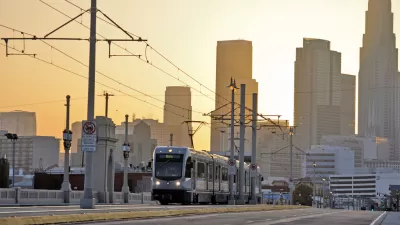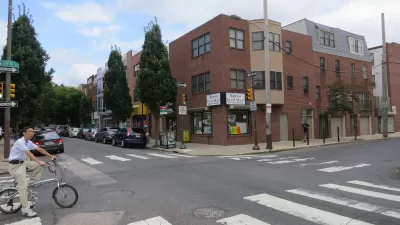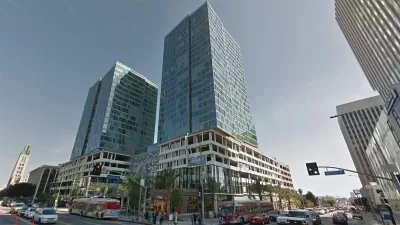Architecture critic Christopher Hawthorne describes an L.A. in flux, at once beholden to its postwar image and pushing in a new direction. The city, he says, faces existential questions on a scale unmatched elsewhere in the nation.

In an interview, Christopher Hawthorne discusses why L.A. may be entering its third great incarnation. "All of us continue to be disappointed by how much of the reading of L.A. just assumes that the city started in 1930 or 1945 [...] Southern California was really built around the convenient marriage between streetcar lines and real estate speculation. That laid down the network on top of which the freeways were built."
After post-WWII suburbanization replaced an older car-less Los Angeles, today's push for public infrastructure is both reversal and revolution. Hawthorne remarks, "An easy way to think about what's happening is there was a time when nine out of every ten changes to a boulevard in L.A. were done with the idea of drivers in mind. Parking lots were added, sidewalks shrunk, buildings were destroyed along boulevards. Now the opposite is true; the vast majority of changes to boulevards are in favor of a balanced street."
Following an era suited to the individual, the city is considering its collective ambitions. "A lot of the basic ways in which the city defines itself are up for grabs in a way that's not true in any other major American city that I can think of. It's not true in San Francisco, New York, or Chicago. Those cities are in many ways fixed. In L.A., existential questions are still up for grabs."
L.A.'s "third era" may well include architectural rediscovery in the public space. Hawthorne says, "[L.A. has] become a very constrained, regulated, and risk-averse place in terms of new architecture. That's still surprising for people outside of L.A. to hear [...] We do have a great history of public space and civic architecture that we lost sight of."
FULL STORY: Q+A> Christopher Hawthorne: Christopher Hawthorne makes the case for a post-suburban city

Depopulation Patterns Get Weird
A recent ranking of “declining” cities heavily features some of the most expensive cities in the country — including New York City and a half-dozen in the San Francisco Bay Area.

California Exodus: Population Drops Below 39 Million
Never mind the 40 million that demographers predicted the Golden State would reach by 2018. The state's population dipped below 39 million to 38.965 million last July, according to Census data released in March, the lowest since 2015.

Pennsylvania Mall Conversion Bill Passes House
If passed, the bill would promote the adaptive reuse of defunct commercial buildings.

Google Maps Introduces New Transit, EV Features
It will now be easier to find electric car charging stations and transit options.

Ohio Lawmakers Propose Incentivizing Housing Production
A proposed bill would take a carrot approach to stimulating housing production through a grant program that would reward cities that implement pro-housing policies.

Chicago Awarded $2M Reconnecting Communities Grant
Community advocates say the city’s plan may not do enough to reverse the negative impacts of a major expressway.
City of Costa Mesa
Licking County
Barrett Planning Group LLC
HUD's Office of Policy Development and Research
Mpact Transit + Community
HUD's Office of Policy Development and Research
City of Universal City TX
ULI Northwest Arkansas
Town of Zionsville
Urban Design for Planners 1: Software Tools
This six-course series explores essential urban design concepts using open source software and equips planners with the tools they need to participate fully in the urban design process.
Planning for Universal Design
Learn the tools for implementing Universal Design in planning regulations.


























